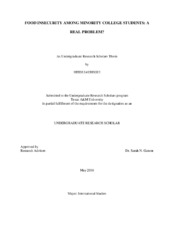| dc.description.abstract | Being part of the community is a process that is linked to other privileges in society. As Marshall stated, “citizenship is a status bestowed on those who are full members of the community” (1 Marshall, 1963: 87). People with the right to citizenship are benefited in many ways, but at the same time history demonstrates that citizenship is often a tool wielded to define inclusion and exclusion in vastly unequal ways because “citizenship operated as an instrument of social stratification” (1 Marshall, 1963: 78). This causes people that belong in minority groups to have fewer privileges and advantages, which may lead to food insecurity. “Food insecurity may occur when access to or availability of sufficient amounts of healthy, culturally-appropriate and nutritious foods are compromised, or when individuals cannot access these foods in socially-acceptable ways” (2 Gallegos et.al. 2013: 498). When people suffer from food insecurity their lives are greatly affected, with much attention focused on the impact to their health and performance at work or school, as “the association between food insecurity and poor health is likely to be a consequence of poor nutrition, stress associated with the inability to procure sufficient food, or both” (2 Gallegos et.al. 2013: 504). At the same time, “food insecure students were more likely than food secure students to report a lower GPA (2.0-2.49) versus a higher GPA (3.5-4.0)” thus showing the effect of food insecurity in grade point average (3 M.E. Maroto Et al. 2015: 515). It is well documented that minority groups are more likely than white groups to suffer from food insecurity, however there is a lack of studies focusing on minority university students. The main purpose of this research is to find if students at Texas A&M are being affected by food insecurity, and if so, also determine if there is a link between food insecurity and ethnicity, for example, to find if there is a greater percentage of food insecure minority college students than white college students. Lastly, if there is a problem with food insecurity I would suggest different solutions to this problem as well as identify the stakeholders that need to address this problem. | en |


